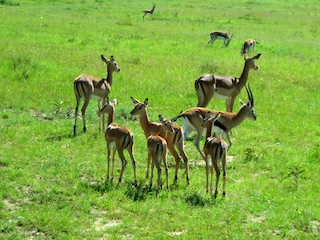Kenya Safari Compared To Other African Safaris
When it comes to wild life safaris, Kenya stands out as a premier spot. It offers a unique blend of land scapes, wild life, and culture experiences. This sets it apart from other African safari spots. While Africa as a whole boasts incredible safari experiences, a Kenya safari provides unique things that make it a must visit for everyone. This article will explore how a Kenya safari differs from other African safaris, its exceptional things and diverse lands.
Allure of a Kenya safari
The appeal of a Kenya safari appeal lies in its diverse land scapes and rich wild life experiences. From the iconic Maasai Mara to the Samburu national reserve, Kenya offers a variety of environments that cater to different interests. What truly sets a Kenya safari from other African safaris is the combination of it’s dramatic scenery, the unique events, and its deep rooted culture heritage.
Maasai Mara and the Great Migration
One of the primary thing of a Kenya safari is the Maasai Mara national reserve for its role in the Great Migration. This event, occurs from July to October, when millions of wilde beest and zebras move across Serengeti-Mara edge in search of fresh grazing lands. The Maasai Mara’s position at the northern end of this route allows visitors to witness this natural event from both the Kenyan and Tanzanian sides.
Compared to other African safari spots, few locations offer the same front seat to such an epic event. While other regions, like Botswana’s Okavango Delta or South Africa’s Kruger national park, offer exceptional wild life experiences, the sheer scale and drama of the Great Migration of a Kenya safari provide a unique opportunity that sets Kenya apart.
Diverse eco systems and land scapes
Kenya’s diverse eco systems adds to its unique safari experiences. The country is home to a variety of land scapes, each different, offering unique experiences. For example:
-
- Maasai Mara: Known for its plains and rich wild life, the Maasai Mara is iconic for both the Great Migration and its populations of big cats, such as lions, cheetah, and leopard.
- Amboseli national park: Famous for its views of Mount Kilimanjaro and large herds of elephants, Amboseli provides a different kind of safari experience with its open plains and elephant herds against the back drop of Africa’s highest peak.
- Samburu national reserve: Located in northern Kenya, Samburu differs from the more familiar plain environments. Its arid land scapes are home to unique species, including the Grevy’s zebra, Somali ostrich, and the reticulated giraffe, which are not found in many other safari spots.
- Lake Nakuru national park: Renowned for its flamingo populations, Lake Nakuru offers a unique aquatic safari experience with its birdlife and the chance to see white and black rhinos.
Each of these regions provides a distinct safari experience, showcasing Kenya’s diverse natural beauty and wildlife, unlike other African destinations that might offer more homogeneous landscapes.
Unique wildlife encounters
While Africa as a whole is known for its impressive wildlife, Kenya offers some unique encounters that can differ from those available in other safari destinations. The country’s varied habitats are home to specific species and behaviors that might not be as easily observed elsewhere.
Big Five and Beyond
Kenya is home to the Big Five—lion, leopard, elephant, rhinoceros, and buffalo—each of which can be observed in different regions of the country. The Maasai Mara, Amboseli, and Samburu are all excellent locations for spotting these iconic species. However, Kenya also provides opportunities to see other fascinating wildlife that might not be as prevalent in other regions.
For instance, the reticulated giraffe, which has a distinctive geometric pattern, can be spotted in Samburu. Similarly, the Grevy’s zebra, a rare zebra species with narrow stripes, is found in this northern reserve but is less common elsewhere.
Unique behavioural observations
Kenya’s diverse habitats also offer opportunities to witness unique animal behaviors. In the Maasai Mara, visitors might observe dramatic predator-prey interactions during the Great Migration. In Amboseli, the behavior of large elephant herds in the shadow of Mount Kilimanjaro provides a distinct viewing experience.
Moreover, Kenya’s safari experiences are often enhanced by the expertise of local guides. Many guides are members of the Maasai or other local communities and have an intimate knowledge of the wildlife and ecosystems, enriching the safari experience with their cultural and ecological insights.
Cultural encounters and community involvement
A Kenya safari is not just about wildlife; it also offers rich cultural experiences that set it apart from other African safaris. Kenya’s safari experience is deeply intertwined with its diverse cultures, providing visitors with the opportunity to engage with local communities and learn about their traditions and lifestyles.
Maasai culture
The Maasai people, with their vibrant dress and traditional customs, are perhaps the most famous cultural group associated with Kenya. Many safari itineraries include visits to Maasai villages, where visitors can experience traditional dances, learn about Maasai customs, and gain insight into their way of life. This cultural component adds a valuable dimension to the safari experience, offering a deeper understanding of the region beyond its wildlife.
Other local communities
In addition to the Maasai, Kenya is home to various other ethnic groups, each with its own unique traditions. For instance, in the northern regions of Kenya, visitors might interact with the Samburu people, who share cultural similarities with the Maasai but have their own distinct practices and attire. Engaging with these communities enriches the safari experience, providing a broader perspective on Kenya’s cultural landscape.
Conservation efforts and sustainable tourism
Kenya is a leader in conservation and sustainable tourism. This is a significant factor in its appeal as a safari destination. The country’s approach to conservation not only protects its wildlife but also ensures that tourism benefits local communities.
National parks and reserves
Kenya’s national parks and reserves are managed with a focus on conservation and sustainable tourism. The revenue generated from tourism helps fund anti-poaching efforts, habitat preservation, and community development projects. By supporting these initiatives, visitors contribute to the protection of Kenya’s natural heritage and the well-being of local communities.
Community-based tourism
Kenya’s commitment to community-based tourism is another aspect that differentiates it from other safari destinations. Many safari lodges and camps are involved in local community projects, providing employment and supporting social development. This approach ensures that tourism benefits extend beyond the wildlife and helps foster positive relationships between visitors and local residents.
Practical considerations for a Kenya safari
Planning a Kenya safari involves several practical considerations that can influence your experience. Understanding these factors will help you make the most of your trip and appreciate what sets Kenya apart.
Travel logistics
Kenya is well-connected with international airports in Nairobi and Mombasa, making it relatively easy to reach. Internal flights and road transfers are commonly used to access different safari regions. Kenya’s well-developed infrastructure supports seamless travel between destinations, allowing visitors to experience a variety of environments within a single trip.
Health and safety
Kenya is a safe destination for travelers, though it’s important to follow health precautions. Malaria prophylaxis may be recommended for certain regions, and travelers should be aware of any vaccination requirements. Ensuring you have travel insurance and understanding local health guidelines will contribute to a safe and enjoyable safari experience.
Best time to visit
The best time for a Kenya safari depends on what you want to see. The Great Migration typically occurs from July to October, while other times of the year offer different wildlife experiences. For example, you can view Amboseli’s elephant herds during the dry season when animals congregate around water sources.
Kenya safari stands out
A Kenya safari offers a distinctive adventure that stands out among other African safari experiences. Its diverse landscapes, unique wildlife encounters, and rich cultural experiences provide a multifaceted journey that appeals to a wide range of travellers. Kenya’s safari experience is unparalleled. It offers the iconic Great Migration, the unique species of Samburu and the cultural insights of the Maasai,
A Kenya safari promises an unforgettable adventure. It combines the thrill of wildlife observation with the beauty of diverse landscapes and the depth of cultural engagement. By opting for Kenya, you are not just going on a safari. You are dipping yourself in a vibrant, dynamic environment that offers some of the most exceptional safari experiences in Africa.





